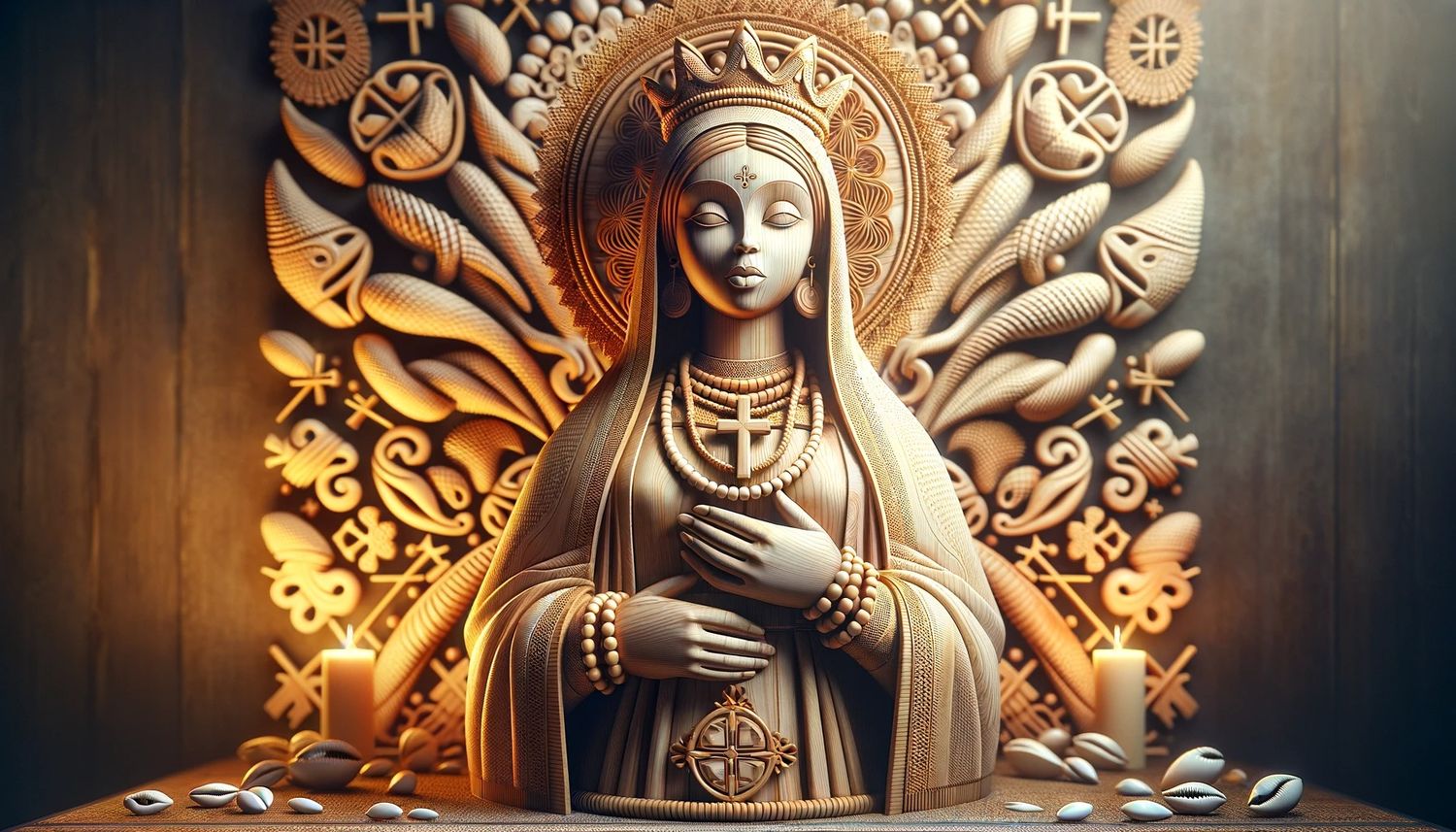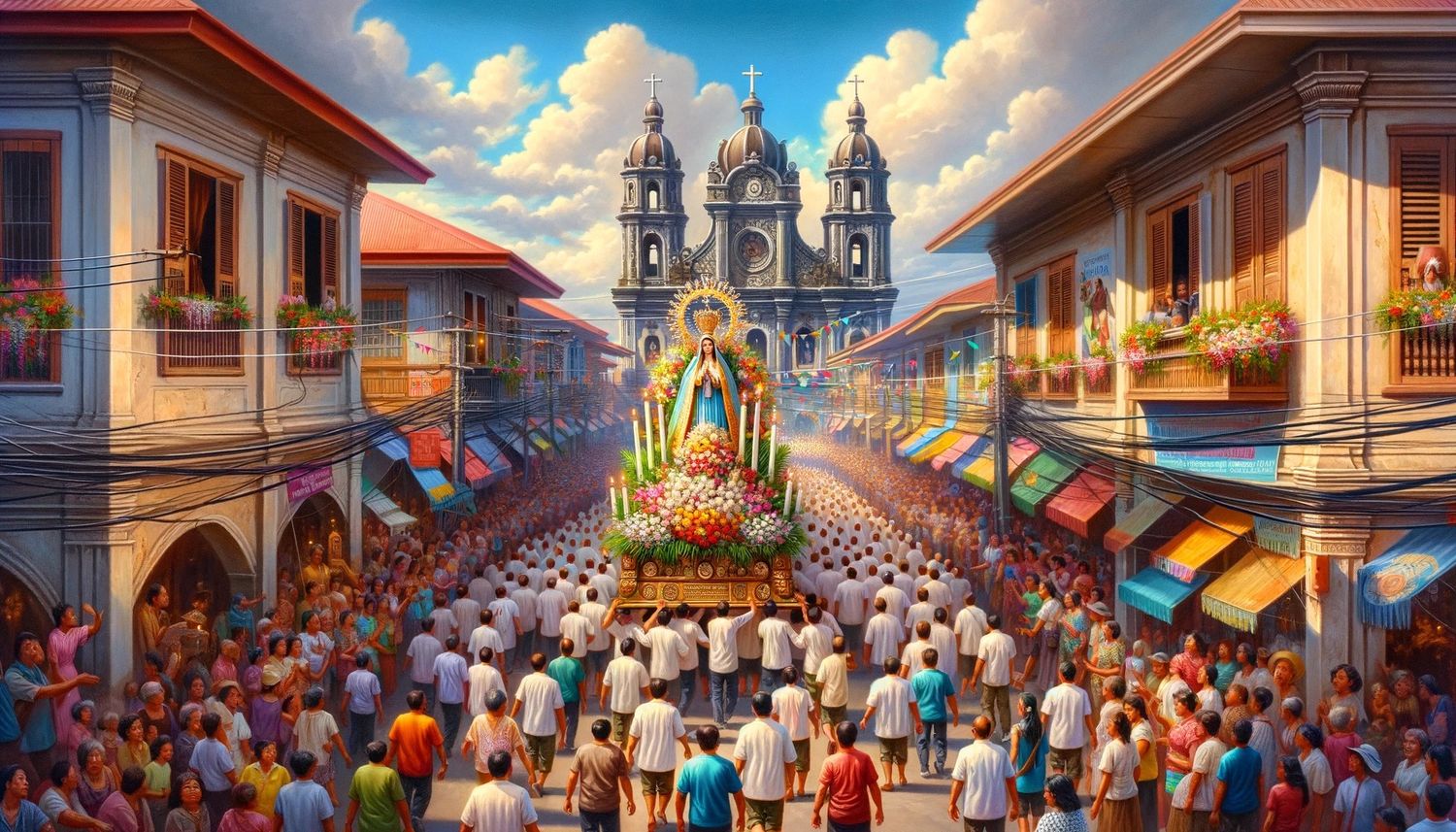Home>Theology and Spirituality>Which Religion Began In Cuba And Combined Yoruba Beliefs With Catholicism?


Theology and Spirituality
Which Religion Began In Cuba And Combined Yoruba Beliefs With Catholicism?
Published: February 17, 2024
Ericka Andersen, an editor at Christian.net, expertly merges digital strategy with content creation, focusing on faith and societal issues. Her communication skills enhance the platform's engaging narratives, fostering meaningful dialogue on belief's impact on society.
Discover the unique religious fusion that originated in Cuba, blending Yoruba beliefs with Catholicism. Explore the rich history and cultural significance of this fascinating theological and spiritual tradition.
(Many of the links in this article redirect to a specific reviewed product. Your purchase of these products through affiliate links helps to generate commission for Christian.net, at no extra cost. Learn more)
Table of Contents
Introduction
Cuba, a vibrant and culturally rich island in the Caribbean, has been a melting pot of diverse religious and spiritual traditions. Among the various belief systems that have taken root in Cuba, one stands out for its unique blend of African and European influences: Santeria. This syncretic religion, which combines Yoruba beliefs with Catholicism, has deep roots in Cuban history and continues to thrive as a significant aspect of the island's cultural tapestry.
Santeria's origins can be traced back to the arrival of African slaves in Cuba during the colonial era. These enslaved individuals brought with them the spiritual practices and deities of the Yoruba people, who hail from what is now Nigeria and Benin. Despite the oppressive conditions they faced, the African slaves managed to preserve and adapt their religious traditions in the new and unfamiliar environment of Cuba.
At the same time, Catholicism was being introduced to the island by Spanish colonizers. The forced conversion of the enslaved Africans to Catholicism led to a fascinating interplay between the two belief systems. Rather than abandoning their ancestral faith, the Yoruba people in Cuba found ways to merge their religious practices with elements of Catholicism, resulting in the emergence of Santeria.
Santeria, also known as Regla de Ocha or La Regla de Ifá, represents a harmonious fusion of Yoruba spirituality and Catholicism, creating a complex and multifaceted religious framework. This syncretism is characterized by the identification of Yoruba deities, or orishas, with Catholic saints, allowing for the coexistence of both belief systems within the same religious context.
As we delve into the intricate tapestry of Santeria, it becomes evident that this unique blend of Yoruba and Catholic traditions has not only endured but also flourished over the centuries. The influence of Santeria extends beyond the boundaries of Cuba, reaching communities in the United States, Latin America, and other parts of the world, where it continues to captivate the hearts and minds of those drawn to its spiritual depth and cultural significance.
In the following sections, we will explore the individual components of Yoruba beliefs and Catholicism in Cuba, leading to a deeper understanding of how these elements converged to give rise to the vibrant and enigmatic tapestry of Santeria.
Read more: Which Religion Is Most Like Catholicism
Yoruba Beliefs in Cuba
The arrival of African slaves in Cuba during the colonial period brought with it the rich and intricate tapestry of Yoruba beliefs. The Yoruba people, hailing from what is now Nigeria and Benin, possessed a deeply spiritual and complex religious system that revolved around the veneration of orishas, or deities, as well as the practice of divination and ancestral worship.
Despite the harsh conditions of slavery, the Yoruba people managed to preserve and adapt their religious traditions in the unfamiliar terrain of Cuba. Central to their belief system were the orishas, revered as intermediaries between humans and the supreme deity, Olodumare. Each orisha embodied distinct characteristics and powers, governing aspects of nature, human endeavors, and the cosmos. From the fiery Shango, associated with thunder and lightning, to the nurturing Yemaya, symbolizing the vastness of the ocean, the orishas represented a diverse pantheon that resonated deeply with the spiritual consciousness of the Yoruba people.
Moreover, the practice of divination, particularly through the use of the Ifá oracle, held significant importance in Yoruba spirituality. Ifá priests, known as babalawos, served as custodians of this ancient wisdom, interpreting the messages of the oracles and providing guidance on matters of destiny, morality, and ethical conduct.
Ancestral veneration also formed an integral part of Yoruba beliefs, emphasizing the continuity of familial bonds and the enduring presence of departed ancestors in the lives of the living. Through rituals and offerings, the Yoruba people honored their ancestors, seeking their guidance and blessings in various aspects of life.
The resilience and adaptability of Yoruba beliefs in Cuba are testament to the profound spiritual and cultural legacy of the Yoruba people. Despite the challenges they faced, they managed to preserve the essence of their faith, laying the foundation for the eventual convergence with Catholicism to give rise to the syncretic tradition of Santeria.
The enduring presence of Yoruba beliefs in Cuba serves as a testament to the resilience and adaptability of the human spirit, as well as the profound impact of cultural and spiritual exchange in shaping the identity of a nation.
Catholicism in Cuba
Catholicism has played a pivotal role in shaping the religious and cultural landscape of Cuba. Introduced by Spanish colonizers during the early stages of the island's colonial history, Catholicism quickly became entrenched as the dominant faith, exerting a profound influence on the lives of the Cuban people.
The arrival of Catholicism in Cuba brought with it a rich tapestry of religious rituals, traditions, and iconography. Churches, cathedrals, and religious processions became integral elements of the Cuban social fabric, serving as focal points for communal worship and spiritual expression. The veneration of saints, the observance of religious feast days, and the sacramental life of the Church became deeply ingrained in the daily lives of the Cuban populace.
Moreover, the Catholic faith permeated various aspects of Cuban culture, influencing art, music, literature, and societal norms. Religious imagery and symbolism found expression in the vibrant art forms and architectural marvels that adorned the island, reflecting the fusion of European religious aesthetics with indigenous sensibilities.
The Catholic Church also played a significant role in the education and healthcare systems of Cuba, establishing schools, hospitals, and charitable institutions that catered to the needs of the local communities. The presence of Catholic missionaries and clergy contributed to the dissemination of religious teachings and the provision of social services, further solidifying the Church's impact on Cuban society.
Despite the dominance of Catholicism, the arrival of African slaves and the subsequent blending of their spiritual traditions with Catholicism gave rise to a unique syncretic religious expression known as Santeria. This syncretism, characterized by the fusion of Yoruba beliefs with Catholic elements, reflects the dynamic interplay between diverse cultural and religious influences in Cuba.
The enduring legacy of Catholicism in Cuba is a testament to its enduring impact on the nation's history, culture, and identity. While the religious landscape of Cuba has evolved over time, the imprint of Catholicism remains deeply embedded in the collective consciousness of the Cuban people, serving as a testament to the enduring power of faith and cultural exchange.
The rich tapestry of Catholicism in Cuba continues to resonate through the ages, weaving a narrative of spiritual resilience, cultural diversity, and the enduring quest for transcendence.
Santeria: The Combination of Yoruba Beliefs and Catholicism
Santeria, also known as Regla de Ocha or La Regla de Ifá, represents a harmonious fusion of Yoruba spirituality and Catholicism, creating a complex and multifaceted religious framework. This syncretism is characterized by the identification of Yoruba deities, or orishas, with Catholic saints, allowing for the coexistence of both belief systems within the same religious context.
At the heart of Santeria lies the intricate process of syncretization, wherein the orishas of the Yoruba pantheon became associated with specific Catholic saints. This symbolic merging of deities facilitated the preservation of Yoruba spiritual practices under the veneer of Catholicism, enabling the enslaved Africans to continue their worship in a clandestine manner. For instance, the orisha Oshun, associated with love, fertility, and rivers, became linked with the Catholic figure of Our Lady of Charity, while the warrior orisha Ogun found resonance with Saint Peter, the guardian of the gates of heaven.
The syncretic nature of Santeria is further exemplified through its rituals and ceremonies, which seamlessly blend elements of Yoruba traditions with Catholic liturgical practices. Drumming, dancing, and the invocation of orishas during religious gatherings reflect the vibrancy and spiritual fervor of Yoruba rituals, while incorporating Catholic prayers and hymns as a testament to the syncretic nature of the faith.
Moreover, the practice of divination, central to Yoruba spirituality, found continuity within the framework of Santeria through the utilization of the Ifá oracle, which persisted alongside Catholic forms of prophecy and oracular guidance. This convergence of divinatory practices underscores the intricate interweaving of Yoruba and Catholic elements within the fabric of Santeria.
The syncretic nature of Santeria not only allowed for the preservation of Yoruba beliefs in the face of oppression but also facilitated the covert transmission of ancestral wisdom and cultural heritage across generations. This adaptive resilience enabled the enslaved Africans to maintain a sense of spiritual continuity and communal identity, despite the adversities they encountered.
Santeria's syncretic tapestry continues to captivate scholars, practitioners, and spiritual seekers alike, offering a profound testament to the enduring legacy of cultural exchange and the resilience of faith in the face of adversity. The intricate fusion of Yoruba beliefs and Catholicism within the framework of Santeria stands as a testament to the enduring power of syncretism in shaping the spiritual landscape of Cuba and beyond.
Spread and Influence of Santeria in Cuba and Beyond
The influence of Santeria extends far beyond the shores of Cuba, permeating diverse cultural landscapes and captivating the hearts and minds of individuals across the globe. As a result of historical migrations and diasporic movements, Santeria has taken root in various countries, including the United States, Puerto Rico, Venezuela, and other parts of the Caribbean and Latin America. This widespread dissemination of Santeria has contributed to its enduring impact on the spiritual and cultural fabric of these regions.
In Cuba, Santeria has become an integral part of the nation's identity, intertwining with the social, artistic, and religious spheres of Cuban life. The rhythmic beats of sacred drumming, the vibrant colors of ceremonial attire, and the fervent invocations of orishas during religious gatherings reflect the palpable presence of Santeria within the Cuban cultural milieu. Moreover, the influence of Santeria extends to the realm of music, dance, and visual arts, inspiring creative expressions that resonate with the spiritual essence of the faith.
Beyond Cuba, the diasporic spread of Santeria has engendered vibrant communities of practitioners who continue to uphold and transmit the traditions of the faith. In the United States, particularly in cities such as Miami, New York, and Los Angeles, Santeria has found a devoted following among individuals of Cuban, Caribbean, and Latin American descent. The establishment of botanicas, or spiritual supply stores, and the presence of religious practitioners have contributed to the visibility and influence of Santeria within these communities.
Furthermore, the syncretic nature of Santeria has facilitated its resonance with individuals from diverse cultural backgrounds, transcending geographical boundaries and appealing to seekers of spiritual insight and healing. The adaptability and inclusivity of Santeria have enabled it to thrive in multicultural settings, fostering a sense of interconnectedness and shared spiritual heritage among its adherents.
In addition to its cultural impact, Santeria has garnered academic interest and scholarly inquiry, leading to a deeper understanding of its historical roots, ritual practices, and sociocultural significance. The academic study of Santeria has contributed to the recognition of its enduring legacy and its role in shaping the religious landscape of the Americas.
The enduring influence of Santeria in Cuba and beyond serves as a testament to the resilience of syncretic traditions and their capacity to transcend adversity, preserve cultural heritage, and foster a sense of spiritual interconnectedness among diverse communities. As Santeria continues to evolve and adapt in response to changing social dynamics, its enduring legacy remains deeply intertwined with the rich tapestry of Cuban and transnational cultural expressions.
Read more: What Are The Major Beliefs Of Catholicism
Conclusion
In conclusion, the intricate tapestry of Santeria, born from the convergence of Yoruba beliefs and Catholicism in Cuba, stands as a testament to the enduring power of cultural exchange, resilience, and spiritual adaptation. The syncretic fusion of these diverse traditions has given rise to a vibrant and enigmatic faith that continues to captivate the hearts and minds of individuals across Cuba and beyond.
Santeria's origins, rooted in the arrival of African slaves and the subsequent blending of their spiritual practices with Catholicism, exemplify the transformative power of syncretism in the face of adversity. The preservation of Yoruba beliefs within the framework of Santeria reflects the resilience and adaptability of the human spirit, as well as the enduring quest for spiritual continuity and communal identity.
Furthermore, the influence of Santeria extends far beyond the shores of Cuba, permeating diverse cultural landscapes and captivating the hearts and minds of individuals across the globe. The diasporic spread of Santeria has engendered vibrant communities of practitioners who continue to uphold and transmit the traditions of the faith, fostering a sense of interconnectedness and shared spiritual heritage among its adherents.
Moreover, the enduring influence of Santeria in Cuba and beyond serves as a testament to the resilience of syncretic traditions and their capacity to transcend adversity, preserve cultural heritage, and foster a sense of spiritual interconnectedness among diverse communities. As Santeria continues to evolve and adapt in response to changing social dynamics, its enduring legacy remains deeply intertwined with the rich tapestry of Cuban and transnational cultural expressions.
In essence, the story of Santeria is one of resilience, cultural exchange, and the enduring quest for spiritual transcendence. It serves as a poignant reminder of the transformative power of syncretism and the capacity of diverse traditions to coexist and evolve, shaping the spiritual landscape of nations and transcending the boundaries of time and place. As we reflect on the intricate tapestry of Santeria, we are reminded of the enduring legacy of cultural exchange and the profound resilience of the human spirit in the pursuit of spiritual continuity and communal identity.














